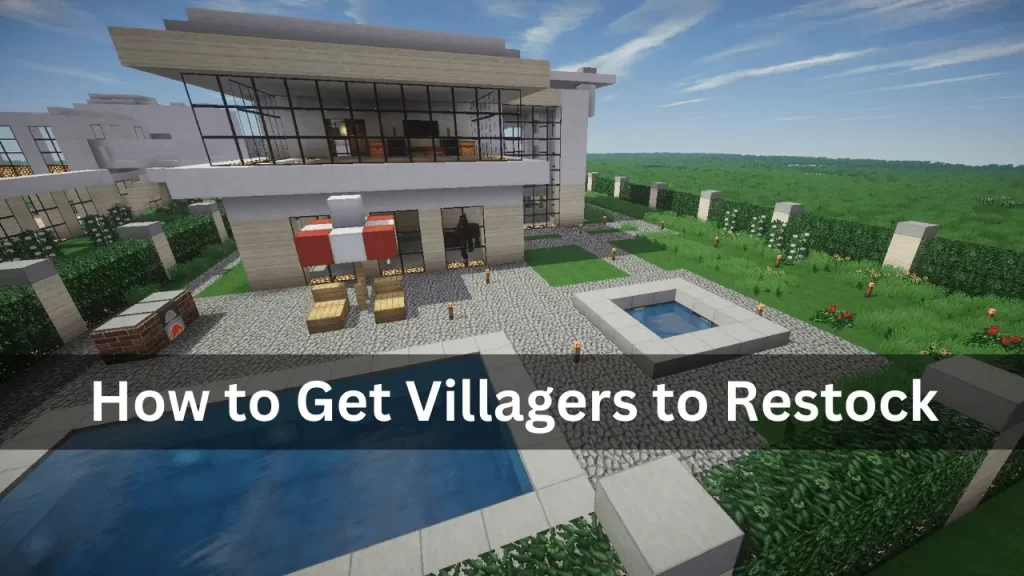
Restocking is an essential aspect of managing villagers in games like Minecraft, where their trades offer valuable resources and items. Whether you’re looking to replenish supplies or unlock new trade options, understanding how to get villagers to restock is crucial. By implementing specific strategies and meeting certain requirements, you can ensure a steady flow of restocked trades from your villagers.
In this guide, we will explore the mechanics behind villager restocking and provide you with practical tips to encourage this process. We’ll discuss the importance of workstations, the role of beds, the influence of food availability, and the significance of creating a secure environment within the village. Additionally, we’ll cover the benefits of trading with villagers and the possibility of waiting for natural restocking to occur.
By following these techniques and utilizing the information presented here, you’ll be equipped with the knowledge to effectively manage and maximize the potential of your villagers’ restocking capabilities. So, let’s delve into the world of villager restocking and discover how to ensure a thriving trading economy in your Minecraft village.
How to Get Villagers to Restock
Understanding Villager Restocking Mechanics
To effectively get villagers to restock, it’s essential to grasp the mechanics behind this process. Villagers have specific requirements and conditions that need to be met in order for them to restock their trades. Understanding these mechanics will help you create an environment that promotes restocking and keeps your trading options plentiful.
One crucial aspect of villager restocking is the presence of workstations. Workstations are blocks that correspond to a villager’s profession, such as a lectern for librarians or a brewing stand for clerics. These workstations are essential for villagers to acquire new trades and restock their existing ones. Here are some key points to consider when providing workstations for villagers:
- Assigning workstations: Each villager needs access to a designated workstation to establish their profession. When a villager is close to an unclaimed workstation, they will attempt to claim it, and their profession will be determined accordingly. To ensure villagers have the opportunity to claim workstations, you should have an adequate number of workstations available in the village.
- Maintaining workstations: Once a villager has claimed a workstation, it’s crucial to ensure that the workstation remains accessible to them. This means preventing other villagers from occupying or using the claimed workstation. It’s recommended to have a one-to-one ratio of workstations to villagers to avoid any conflicts.
- Upgrading workstations: Workstations can be upgraded to higher-tier versions, which offer more lucrative trades. For example, upgrading a librarian’s lectern to a higher-level lectern can unlock valuable enchanted book trades. Keep an eye out for opportunities to upgrade workstations and enhance the trade options available to your villagers.
By providing sufficient and properly maintained workstations, you create an environment that encourages villagers to restock. This, in turn, ensures a steady supply of new trades and valuable items for your Minecraft village. Now that you understand the importance of workstations in villager restocking, let’s move on to the next section: “Maintaining Sufficient Beds for Villagers.”
Maintaining Sufficient Beds for Villagers
In order for villagers to restock their trades, it’s crucial to ensure they have access to sufficient beds. Beds play a vital role in the lives of villagers, as they serve as a key component for their work and rest schedule. Here are some important factors to consider when maintaining sufficient beds for villagers:
Bed-to-villager ratio
It’s important to have an appropriate number of beds relative to the number of villagers in your village. Each villager requires a bed to claim as their own, and having an insufficient number of beds can hinder their ability to restock. Aim for a one-to-one ratio of beds to villagers to ensure that everyone has a designated place to sleep.
Bed placement
The placement of beds is also essential for villagers to recognize and use them. Beds should be easily accessible and not obstructed by other objects or blocks. Ensure that there is ample space around each bed for villagers to navigate and claim their designated sleeping spot.
Protection from mobs
It’s crucial to protect villagers and their beds from hostile mobs. By providing adequate lighting and implementing suitable defensive measures, such as walls or fences around the village, you can create a secure environment that keeps villagers safe during the night. This allows them to sleep peacefully and maintain their restocking routines without interruptions.
By maintaining a proper bed-to-villager ratio, placing beds strategically, and ensuring protection from mobs, you create an environment that supports the restocking process. A well-rested and secure population of villagers will be more motivated to engage in trades and replenish their stock of items.
Ensuring Villagers Have Access to Food
To encourage villagers to restock, it’s essential to ensure that they have access to an adequate food supply. Food availability directly impacts their willingness to engage in trades and restock their inventory. Here are some key points to consider when ensuring villagers have access to food:
Crop farming
Set up a sustainable crop farming system within your village. This can include growing crops like wheat, carrots, potatoes, or beetroot. Villagers can harvest and consume these crops, ensuring they are well-fed and motivated to restock.
Trading for food
Some villagers, such as farmers, have specific food-related trades. By engaging in these trades and providing villagers with the food items they desire, you ensure that they have access to a varied diet and are more inclined to restock.
Sharing surplus food
Make sure to share surplus food with your villagers. You can throw food items at them, and they will pick them up and consume them, keeping their hunger levels satisfied. This promotes a healthy and thriving village economy.
By guaranteeing that your villagers have access to a consistent and diverse food supply, you create an environment that encourages restocking and trading activities. Well-nourished villagers are more likely to engage in trades and maintain a steady inventory of items.
Creating a Secure Village Environment
Creating a secure village environment is vital for encouraging villagers to restock and engage in trade activities. Safety and protection from external threats enable villagers to focus on their daily routines without fear of danger or disruption. Here are some key considerations when creating a secure village environment:
Lighting
Proper lighting is essential to ward off hostile mobs. Illuminating the village and its surroundings with torches or other light sources prevents mob spawns and ensures the safety of villagers during the night.
Fencing or walls
Constructing fences or walls around the village perimeter adds an extra layer of security. This physical barrier helps keep villagers and their valuable assets protected from external threats, allowing them to carry out their tasks without disturbance.
Trading with Villagers to Trigger Restocking
One effective way to encourage villagers to restock is by actively engaging in trades with them. Trading not only benefits you as a player but also stimulates villagers to replenish their stock of items. Here are some tips on trading with villagers to trigger restocking:
Unlocking trades
Villagers start with a limited set of trades, but as you trade with them, new trades become available. By continuously trading and unlocking new trade options, you provide villagers with the opportunity to restock their inventory. Be sure to explore the trade options of different villagers to maximize the variety of items available for trade.
Trading surplus items
Villagers have a finite number of available trades per day. To maximize restocking, trade with them until they exhaust their initial trade offerings. However, it’s important to note that once villagers restock, their trades reset, and they might offer different items. Therefore, avoid completely depleting a villager’s stock if you specifically want certain items.
Refreshing trades
If a villager’s trades aren’t restocking as quickly as desired, you can refresh their trades by breaking and replacing their corresponding workstation. This prompts the villager to reclaim the workstation and triggers a restock of their trades. This method can be useful if you’re looking to obtain specific items from a particular villager.
By actively trading with villagers and unlocking new trade options, you create a cycle of restocking that keeps their inventory fresh and varied. Trading is not only beneficial for your gameplay but also serves as a trigger for villagers to replenish their stock and offer a wider range of items.
Waiting for Villagers to Restock Naturally
While actively trading with villagers is a reliable method to trigger restocking, it’s also possible to wait for villagers to restock naturally. Restocking occurs gradually over time, allowing villagers to renew their trades without player intervention. Here are some important points to consider when waiting for villagers to restock naturally:
Patience
Restocking naturally takes time, and villagers may not replenish their trades immediately. It’s essential to be patient and give them sufficient time to restock their inventory. Avoid trading with them excessively in a short period, as this can disrupt their restocking process.
Idle time
Villagers need idle time to restock their trades. Ensure that villagers have moments of uninterrupted idleness, where they can engage in restocking activities. Avoid overburdening them with excessive tasks or constantly interacting with them, as this may hinder their restocking progress.
Nighttime restocking
Villagers are more likely to restock during nighttime. When night falls, villagers return to their designated beds to rest, allowing them to reset their trades. Ensure that they have access to beds and create a safe environment for them to rest undisturbed.
By allowing villagers time and space to restock naturally, you create an environment that supports their regular trade renewal. Patience and providing appropriate rest periods contribute to a consistent restocking cycle, ensuring a continuous supply of new trades and items.
As you implement these strategies for trading with villagers and patiently wait for them to restock, you’ll witness a thriving economy within your Minecraft village. Villagers will maintain a varied inventory, providing you with valuable resources and enhancing your gameplay experience.
Frequently Ask Questions FAQs
Q. How often do villagers restock their trades?
Ans. Villagers restock their trades at various intervals, but it typically occurs once or twice per Minecraft day. It’s important to provide them with the necessary conditions for restocking and allow them some idle time to refresh their trades.
Q. Do villagers restock their trades if they don’t have a workstation?
Ans. No, villagers require access to their designated workstations to restock their trades. Without a workstation, they won’t be able to renew their trades. Ensure that each villager has a nearby workstation corresponding to their profession.
Q. Can I force villagers to restock their trades?
Ans. While you can’t directly force villagers to restock, you can trigger restocking by trading with them or refreshing their trades by breaking and replacing their workstations. These actions create opportunities for villagers to restock their inventory.
Q. What happens if I trade too much with a villager?
Ans. If you trade excessively with a villager in a short period, their initial trade offerings might be depleted. However, they will eventually restock their trades, offering different items. Avoid trading too much if you specifically want certain items from a villager.
Q. Are there any specific requirements for villagers to restock?
Ans. Apart from having access to their workstations, villagers also require beds for resting and a secure environment to avoid being attacked by mobs. Ensure that there is an adequate bed-to-villager ratio and implement proper lighting and defenses to create a safe village environment.

Hi I’m Rajat, I love to read and write articles. I love to write content on different topics on behalf of different companies.
